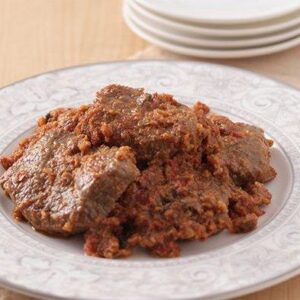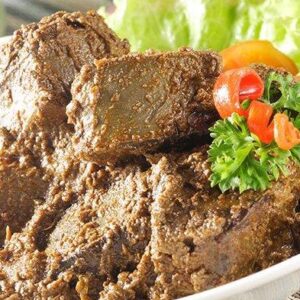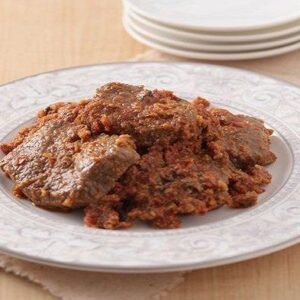This is the only foolproof recipe you need to make the best Beef Rendang!
This is the ultimate Beef Rendang recipe. Soft and tender beef slow cooked in a flavor bomb explosion of a dry coconut curry stew – there’s a reason why this was voted the best food in the WORLD. I’m breaking down all the steps so you can also make a foolproof pot at home. Long list of ingredients, long cooking time, but EASY straightforward steps – totally worth it.
Rendang is an Indonesian dish that is also a staple throughout Singapore and Malaysia. This is a special dish that is a must-have during Malay festivals such as Hari Raya Eid and weddings. This is best served with rice, or Nasi Minyak, or with some lontong and ketupat, or steamed compressed rice cakes.
*Disclosure: This post contains affiliate links that I may earn a small commission – at no additional cost to you. I *only* recommend products I would use myself.
What Type of Beef to Use for Rendang?
The type of beef cut to use is the cheapest cut! These are tough cuts of meat that are best for slow cooking, I usually get the chuck portion. You can also use short ribs. Alternatively, just do what my mom does: ask the butcher for a cut for stewing.
I roughly cut my beef into cubed portions of about 3-4 cm. You can cut it however you like – my mom likes to slice them. Some people would even throw in huge chunks of beef in their rendang. Due to the long cooking time, the beef has plenty of time to soften and tenderize that even the bigger chunks will pull off easily!
The Best Beef Rendang Spice Base Paste


The spice base paste is so crucial; this is where the bulk of the flavors come from. It’s a comprehensive list of ingredients, but you don’t have to prepare it as much – simply pop everything in a blender or food processor turn into a paste.
Dried Chillies: If there is ‘work’, that would be in preparing the dried chillies. Pour boiling water over the dried chillies, and let them rehydrate for about 5 minutes or so. 1You will see the dried chillies becoming more plump. Drain away the hot water, give it another rinse, and cut them up into smaller pieces for easier blending. You can deseed them as well, but cut them open lengthwise, but personally I just let the excess seeds drop out when I cut them up. Not everything will be removed, but I’m fine with that. For even lesser work, use dried chili paste. You can also replace it with Sambal Oelek.
This is not essentially a spicy dish. The amount of dried chillies is not that much to create too much heat. If you really cannot take the heat, simply remove the dried chillies. Although the dried chillies are a must in the Singapore and Malaysian rendang recipes, the original Indonesian recipe does not actually call for dried chillies.
Essential Ingredients for Beef Rendang: Rustle
Rustleor toasted coconut butter, is the single most important ingredient for rendang. Kerisik is basically grated coconut that is toasted until brown, and pounded until it turns into a kind of melted caramel. You can make this at home with desiccated coconut, but I’ve never made it myself. Here in Asia, we have the luxury of kerisik being easily available in our supermarkets. Try to look for it in Asian grocers, otherwise I found Kerisik on Amazon.
UPDATE: You can easily make kerisik from scratch! See the full recipe right here.
If there’s no kerisik, it’s just not rendang. It gives rendang its signature nutty texture and taste. If you really cannot find kerisik, you can omit it. You will still get an amazing beef stew with incredible depths of flavour. In fact, I make rendang often without crisps and it’s still so delicious, albeit without the signature texture.
Rendang Tip #1: Letting the Meat Sweat
The beginning stages of cooking involve allowing the beef to release liquid and letting the liquid evaporate. This process will prolong the shelf life of the beef. This is a crucial step if you’re planning to keep the rendang for longer. At this stage, the beef might be cooked – this is perfectly fine.
The beef is added after sauteing the spice base paste. You’ll notice the paste becoming liquid-y again. That is the liquid drawn out from the beef. Saute the beef, and once the paste dries back to before you add the beef, that’s when the step is complete.
Obviously, if you’re not making a big batch and you’re finishing your pot the same day, it’s fine to skip this step.
Rendang Tip #2: Slow Cooking
Set the heat to the very minimum to cook the rendang. This would be the lowest possible setting that your stove top has. This might mean a small flame that will almost flicker. Doing this will prevent burning of the spices.
Rendang is best when left to stew for 2 hours. 1 hour at the minimum, but to get the full effect of caramelisation of the coconut milk, the rendang will need 2 hours. Rendang can actually be stewed for even longer than 2 hours. Some households would actually stew it for even longer to get super soft, tender, fall-off-the-bone beef.
Rendang Tip #3: Steer Every 30 Minutes
Although Rendang needs long periods of time to properly stew, the process is effortless! You can essentially leave it alone. You do need to return to the pot at every half hour or so, just to give the pot a stir. This is to give the Rendang an even mix throughout. If left unstirred, you might potentially burn the Rendang that’s at the bottom!
If you find that your rendang is drying out quicker than you’d like, simply add a cup of water to hydrate it! This will give more liquid for the beef to stew in and soften even more. Let the liquid reduce to a dry curry texture.
At the last half hour, check in more often and give it more stirs. Towards the end, most of the liquid would have been evaporated so the rendang would burn more easily.
Rendang Cheats
If you want to make good rendang, you HAVE to let it stew for a long period of time. Not only will this allow the beef to soften, this will also caramelize the coconut milk so it becomes that reduced gorgeous dark brown curry.
However, if you are craving this on a weekday, you can make an easy 30-minute version with chicken, my recipe is right here. I make this whenever my rendang craving hits and I’ve had no complaints. It’s more of a thick curry, than a dry curry, but I always love gravy to ladle all over my rice anyway! In fact, sometimes my guests prefer my chicken rendang to the beef rendang! Their words, not mine!
More Recipes Like This:
If you love this Malay-Indonesian recipe, you might love these too:







